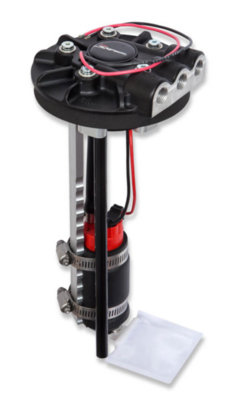Fuel tanks
When installing your EFI system, you'll need to think of how you plan to get fuel out of the tank. This is the second most important thing with EFI with electrical wiring being #1. If you ain't got fuel and good pressure, you're going nowhere or you're going to have issues.
External Pump - If you use an external pump, you can use the factory pickup. The feed from the pickup to the pump will be low pressure. This will allow for a single barb hard line and simple hose clamps. High pressure line will require compression fittings. More on that later. The thing to note here is that the fuel pump should be below the fuel pickup. Electric fuel pumps are pushers and aren't designed to suck fuel out of the lines. If the pump is to high up on the tank, you'll have issues priming the tank.
Internal Pump - If you go with an internal pump you have three choices:
- Buy a New EFI rated retro-fit fuel tank (our '67-70 friends has this one covered!). This is the best and easiest option. Just get a tank and pump from the same manufacture and roll with it.
- Use a fuel cell or custom made tank with baffles. If you're doing this, you won't need me to tell you anything about that.
- Convert an stock tank to EFI tank.
Converting an stock tank to EFI
This isn't as hard as sounds like. What you need in most car is a recess pocket in the corner of the tank to mount the fuel pump. The '74 guys with the hump in the trunk just needs to drill a hole, mount the pump, and call it a day. The rest of use need to break out the grinder and TIG welder.
Before welding any gas tank, be sure to drain all gasoline,
completely fill the tank with water, then let it completely dry. Since gasoline floats on water and doesn't mix, the water will displace the gasoline. If you don't completely fill it, the will still be gas in the tank. I waited a full month before I thought the tank was safe to weld on.
The best way to do this is have a piece of metal laser cut with a hole in the middle for the pump mount, enough surround to clear the pump, and two flaps that can be bent up. There are various online sites that will custom laser cut metals to your specifications. I looked into this, but didn't do this. The welding shop made their own shelf and it looks like a mess.
The Right way:
Laser cut steel, cleanly welded, grounded smooth, lots of room around the pump.
The Wrong Way:
It doesn't leak. Enough said.
Moving right along!
Baffling and Pickup stumps in classic fuel tanks
One down side about converting stock tanks is the lack internal baffling and pickup stumps. Newer car have a stumps that the fuel pump will rest in so that you can get the most out of the tank. Classic car do not.
The aftermarket retrofit units address this issue in different ways. Please review the fuel pumps from the previous post. The tank-inc and Sniper EFI has just a sock. Tank-Efi also makes a pump with a goofy tray. Aero-Equip uses a large fuel cell type material to hold the fuel. My favorite is the Holley with the HydroMat. You can run that tank dry with no issues. The mat adds about $150 to cost of the pump but I think it's worth it if you want to get consistent fuel pressure regardless of the amount of fuel in the system, or when you taking a turn way too dang fast.
Mounting the fuel pump
The Aero-Equip pump has the best mounting by far. I would only trust the Tank Inc design if used with welded on ring with captive nuts. Holley uses little tabs that pops out when you tighten the bolts. It's not the best, wasn't the easiest to work with, but it gets the job done.
Next... Fuel lines..





















